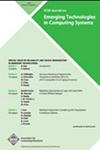Eternal-thing 2.0: Analog-Trojan-resilient Ripple-less Solar Harvesting System for Sustainable IoT
IF 2.1
4区 计算机科学
Q3 COMPUTER SCIENCE, HARDWARE & ARCHITECTURE
引用次数: 1
Abstract
Recently, harvesting natural energy is gaining more attention than other conventional approaches for sustainable IoT. System on chip power requirement for the internet of things (IoT) and generating higher voltages on chip is a massive challenge for on-chip peripherals and systems. In this article, an on-chip reliable energy-harvesting system (EHS) is designed for IoT with an inductor-free methodology. The control section monitors the computational load and the recharging of the battery/super-capacitor. An efficient maximum power point tracking algorithm is also used to avoid quiescent power consumption. The reliability of the proposed EHS is improved by using an aging tolerant ring oscillator. The effect of Trojan on the performance of energy-harvesting system is analyzed, and proper detection and mitigation mechanism is proposed. Finally, the proposed ripple mitigation techniques further improves the performance of the aging sensor. The proposed EHS is designed and simulated in CMOS 90-nm technology. The output voltage is in the range of 3–3.55 V with an input 1–1.5 V with a power throughput of 0–22 μW. The EHS consumes power under the ultra-low-power requirements of IoT smart nodes.Eternal thing 2.0:用于可持续物联网的模拟特洛伊木马弹性无波纹太阳能采集系统
最近,收集自然能源比其他传统的可持续物联网方法受到更多的关注。物联网(IoT)的片上系统功率要求和在片上产生更高的电压对片上外设和系统来说是一个巨大的挑战。在本文中,采用无电感方法为物联网设计了一种可靠的片上能量收集系统(EHS)。控制部分监控计算负载和电池/超级电容器的充电。采用了高效的最大功率点跟踪算法,避免了静态功耗。采用耐老化环形振荡器,提高了系统的可靠性。分析了木马对能量收集系统性能的影响,提出了适当的检测和缓解机制。最后,提出的纹波减缓技术进一步提高了老化传感器的性能。在CMOS 90纳米工艺下设计并仿真了所提出的EHS。输出电压为3 ~ 3.55 V,输入电压为1 ~ 1.5 V,功率吞吐量为0 ~ 22 μW。EHS在物联网智能节点的超低功耗要求下耗电。
本文章由计算机程序翻译,如有差异,请以英文原文为准。
求助全文
约1分钟内获得全文
求助全文
来源期刊
CiteScore
4.80
自引率
4.50%
发文量
86
审稿时长
3 months
期刊介绍:
The Journal of Emerging Technologies in Computing Systems invites submissions of original technical papers describing research and development in emerging technologies in computing systems. Major economic and technical challenges are expected to impede the continued scaling of semiconductor devices. This has resulted in the search for alternate mechanical, biological/biochemical, nanoscale electronic, asynchronous and quantum computing and sensor technologies. As the underlying nanotechnologies continue to evolve in the labs of chemists, physicists, and biologists, it has become imperative for computer scientists and engineers to translate the potential of the basic building blocks (analogous to the transistor) emerging from these labs into information systems. Their design will face multiple challenges ranging from the inherent (un)reliability due to the self-assembly nature of the fabrication processes for nanotechnologies, from the complexity due to the sheer volume of nanodevices that will have to be integrated for complex functionality, and from the need to integrate these new nanotechnologies with silicon devices in the same system.
The journal provides comprehensive coverage of innovative work in the specification, design analysis, simulation, verification, testing, and evaluation of computing systems constructed out of emerging technologies and advanced semiconductors

 求助内容:
求助内容: 应助结果提醒方式:
应助结果提醒方式:


